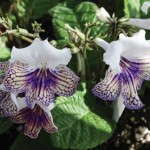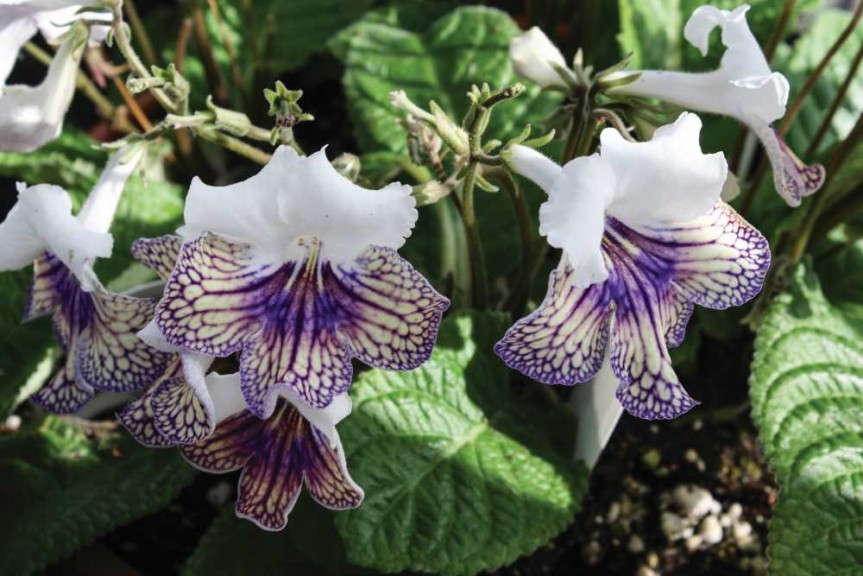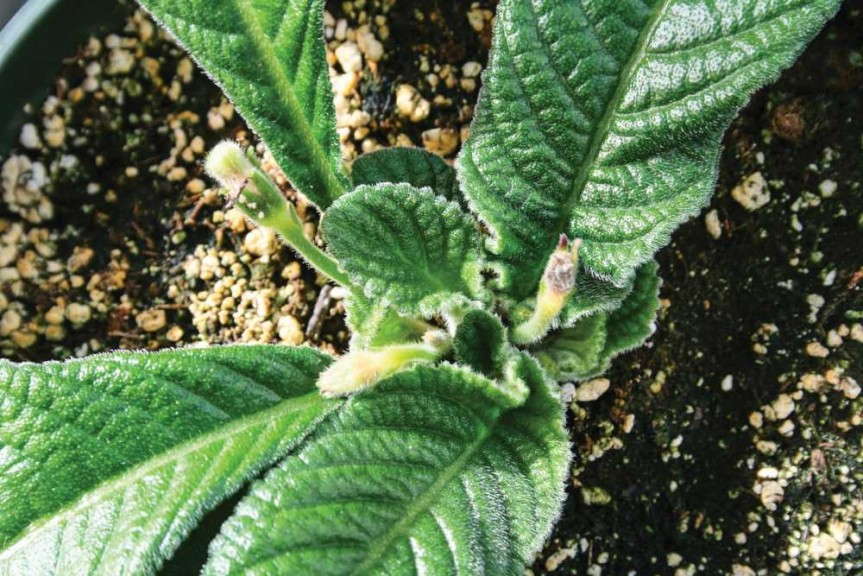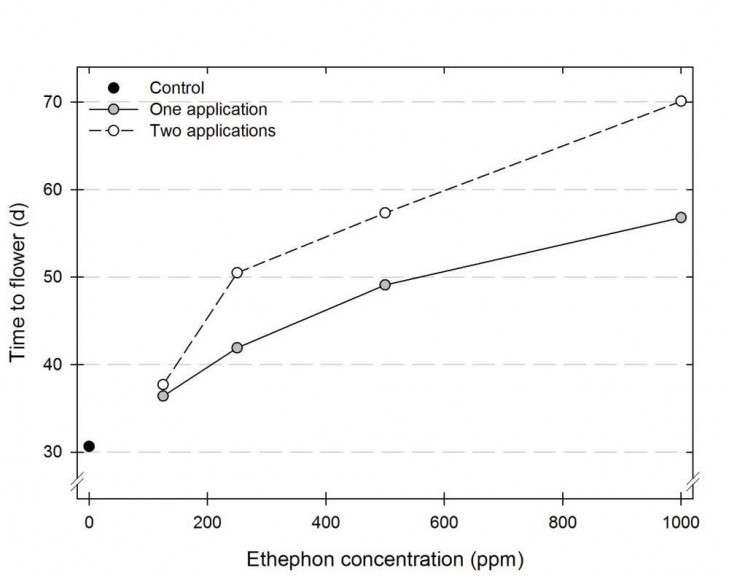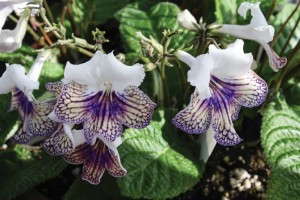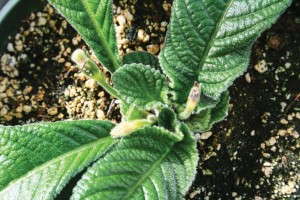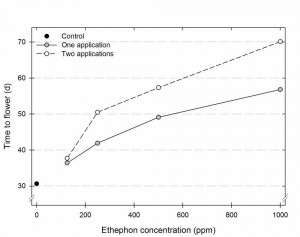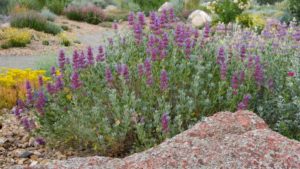Keeping Streptocarpus Vegetative Using Ethephon
Potted streptocarpus are great flowering plants for consumers. Relatively easy to maintain, streptocarpus flourish on a windowsill inside a house or outside in the summer in a shady location. Ladyslippers streptocarpus is a newer series that flowers profusely in a range of colors and patterns. While streptocarpus have traditionally been propagated sexually from F1 hybrid seed, the Ladyslippers series is vegetatively propagated using tissue culture (Figure 1). One challenge with these tissue-cultured plants is that flowering can begin when plants are small and not ready for sale.
[blackoutgallery id=”62244″]
Streptocarpus are not photoperiodic — that is, flowering is not controlled by daylength. While this may be good for growers who don’t have night-interruption lighting or black cloth, it can be more of a challenge to control flowering for crop scheduling. When streptocarpus start to flower prematurely, flowers are usually removed by hand. This is done to: 1) increase the vegetative growth and bulk-up plants to a size suitable for sale; and 2) minimize dead flowers and flower stalks on the plant, which can both harbor disease and appear unsightly.
Ethephon is an ethylene-generating plant growth regulator with several uses in commercial greenhouse crop production. It is commonly used to produce compact plants and to increase branching. However, another popular use of ethephon is to abort flowers and keep plants in a vegetative state. We wanted to evaluate the effectiveness of keeping Ladyslipper streptocarpus plants vegetative using ethephon sprays.
Calculating Time To Flower, Number Of Inflorescences And Growth Index
We planted rooted liners (96-cell) of ‘Ladyslipper Blue Halo,’ ‘Ladyslipper Deep Blue’ and ‘Ladyslipper Red Rose’ streptocarpus into 6-inch round containers filled with a commercial soilless substrate. Plants were grown in a glass-glazed greenhouse with fog cooling, radiant hot-water heating and retractable shade curtains controlled by an environmental computer.
The day and night greenhouse air temperature set points were 73°F and 66°F, respectively, with supplemental lighting provided between 6 a.m. and 10 p.m., when ambient light was low. Plants were irrigated as necessary with water supplemented with water-soluble fertilizer providing 150 ppm nitrogen (N).
Two weeks after planting, we began our ethephon treatments. Foliar spray applications of solutions containing water (control) or 125, 250, 500 or 1000 ppm ethephon (Collate; Fine Americas, Inc.) were applied at a rate of 2 quarts per 100 ft2. Sprays were applied either two weeks after planting (a single application) or two and four weeks after planting (two applications).
The time to flower from planting was calculated when the first flower in a plant opened, and the total number of inflorescences each plant produced was recorded throughout the study. Thirteen weeks after transplanting, the height of the plant from the surface of the substrate to the tallest growing point, and the widths of the plant at the widest point and 90 degrees from the widest point, were recorded. These measurements were used to calculate the Growth Index, an integrated measurement of plant size.
Ethephon Delayed Flowering Without Suppressing Growth
Ethephon delayed flower for all three streptocarpus cultivars (Figure 2), but the effectiveness varied among cultivars with concentration and number of applications. A single application of 500 or 1000 ppm ethephon delayed flowering of ‘Ladyslipper Blue Halo’ by 19 or 26 days, respectively, compared to untreated plants, while 250 to 1000 ppm ethephon applied twice delayed flowering by 20 to 40 days (Figure 3).
Alternatively, a single ethephon application of 125 to 1000 ppm had no effect on the time to flower of ‘Ladyslipper Red Rose.’ Flowering was only delayed when 1000 ppm was applied twice.
Ethephon affected the number of inflorescences differently for all three cultivars of streptocarpus in this experiment. Compared to the untreated control plants, applying 125 to 1000 ppm ethephon once or twice reduced the number of inflorescences of ‘Ladyslipper Blue Halo’ by 24 to 87 percent, whereas two applications of 1000 ppm ethephon reduced the number of inflorescences of ‘Ladyslipper Deep Blue’ by 39 percent. Ethephon did not affect the number of inflorescences compared to untreated ‘Ladyslipper Red Rose’ plants. Although the total number of inflorescences produced for ‘Ladyslipper Blue Halo’ and ‘Ladyslipper Deep Red’ during the study was reduced with ethephon application, this did not reduce the marketability of the plants.
The study was concluded when the size of the plant was large enough to be considered marketable and, at that point, all the plants (regardless of ethephon treatments) had an appropriate amount of flowers to be considered marketable.
The Growth Index of streptocarpus cultivars was minimally affected by ethephon applications. For example, one or two applications of 500 or 1000 ppm ethephon to ‘Ladyslipper Blue Halo’ resulted in plants that had a slightly smaller Growth Index compared to untreated plants. However, although the Growth Index was reduced in response to some ethephon applications, these plants were still considered commercially acceptable and marketable, even with the smaller size. Ethephon did not affect the Growth Index of the other streptocarpus cultivars.
In our study, we did not observe any phytotoxicity with the ethephon concentrations and number of applications with the cultivars in this study. Epinasty (the downward curling of a leaf) or cupping of leaves may result from an over-application of ethephon, but neither were evident on the foliage of strepotocarpus in our work.
Conclusions And Future Research
Ethephon sprays are useful tools in delaying the flowering of Ladyslippers streptocarpus without negatively impacting plant size or marketability at maturity. While we did not use streptocarpus cultivars from other series in this work, it may be worth trialing. For instance, the seed-propagated Cape Cool streptocarpus is a great series for 4-inch containers. However, this series also starts flowering before the vegetative growth has filled in the pots, so ethephon sprays may be useful for this crop, as well.
There was some variation in response to ethephon among the different cultivars used in this work, and there could be different responses with other streptocarpus series. Producers should always perform in-house trials to determine what concentrations will work best for the cultivars they are growing.




